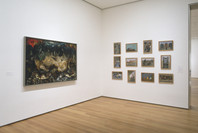These thirty paintings constitute half of the sixty-panel Migration Series, shared between MoMA and the Phillips Collection in Washington, D.C. Lawrence took as his subject the exodus of African Americans from the rural South to Northern cities during and after World War I, when industry's demand for workers attracted them in vast numbers. As the son of migrants, Lawrence had a personal connection to the topic. He researched the subject extensively and wrote the narrative before making the paintings, taking seriously the dual roles of educator and artist.
Lawrence was influenced by the work of the Mexican muralists and earlier artists such as Goya, but he drew his stylistic inspiration primarily from the Harlem community in which he lived. The vivid pattern and color—created in tempera paint as Lawrence worked on all the panels at once—reflect an aesthetic that itself had migrated from the South.
Gallery label from 2012.
Jacob Lawrence: Painter of Black History and Life
Though he came of age before the Civil Rights Movement brought African Americans the rights they had long been denied, Jacob Lawrence (American, 1917–2000) forged a prominent career as an artist, chronicling the story of black life in America through his paintings. Born in New Jersey and raised from the age of thirteen in Harlem, New York City, this Northeast native had southern roots. He was the child of migrants who moved, together with millions of other African Americans, from the impoverished rural South to urban, industrialized Midwestern and Northeastern cities during the mass relocation known as the Great Migration (1915–1950s). Lawrence maintained that he was “a child of the Great Migration,” which shaped the course of his own and his fellow African Americans’ lives.
If the Great Migration provided him with geographical advantages, it was Harlem, then in the midst of the cultural and intellectual outpouring known as the Harlem Renaissance (1920s–1930s), that inspired him to make art. As he once described his beloved neighborhood: “All these people on the street, various colors, so much pattern, so much movement, so much color, so much vitality, so much energy.” The textures of Harlem, and the narrative dynamism of the songs, Bible stories, sermons, and tales of his neighbors’ journeys north that he witnessed in church, shaped Lawrence’s approach to art making. He realized that through painting he, too, could give voice to the experiences of his people.
In 1934, he enrolled in his first art classes. By the time he was twenty-three, he had completed five narrative series on major people and events in black history, including Toussaint L’Ouverture (the leader of the Haitian Revolution), Harriet Tubman (the former slave and abolitionist who smuggled others to freedom on the Underground Railroad), and the Great Migration itself. He used descriptive titles; vibrant patterns and blocks of color; and simplified, angular figures and forms to distill epic narratives into powerfully direct images. This style, applied to topics ranging from neighborhood life to the experiences of black industrial laborers to the Civil Rights Movement, characterized his work throughout his career.
Through his vivid, accessible visual storytelling, Lawrence presented the richness and complexities of African American history and culture to his own community—and beyond. In 1941, with segregation in full force, he broke a racial barrier by becoming the first African American artist whose work was acquired by The Museum of Modern Art.
“A Child of the Great Migration” Tells the Tale
Between 1940 and 1941, while World War II raged and Harlem continued absorbing newly arriving black southerners, a young Jacob Lawrence was busy studying, listening, and painting. He was working on one of the five narrative series through which he chronicled the heroes, heroines, and watershed events of African American history, this one focused on the Great Migration. Before putting brush to panel, he spent months at the library, researching this mass relocation. He also listened to his parents, family, and neighbors tell the tales of their own northward journeys. And he wrote, completing the text for the short narratives that would serve as both titles and explanations for the sixty individual paintings that together comprise his celebrated Migration Series (1940–41).
“I worked very fast,” Lawrence once explained about his process. “From the concept and the drawings to the completion of the works … that may have taken six to eight months …” Needing materials that were both inexpensive and suited to his working method, he used quick-drying tempera paint and hardboard panels. Spreading out all of the panels simultaneously, he sketched images and scenes with a pencil. He then filled in his sketches with a limited range of colors, working with only one color at a time and applying it across all sixty panels. In his words: “I had a very simple palette. I went through all the panels painting yellows, greens, blues, so they’re all the same. I didn’t mix color. I left it pure, as it was, ’cause I wanted the series to be a unit. I consider it one work, not 60 works.”
Lawrence focused on the people at the heart of the Great Migration, breaking apart this mass relocation of millions into intimate vignettes, often centered upon human figures. Each one is spare, in keeping with the artist’s belief that a lot of information could be conveyed through limited visual means. In the panel titled In the North the Negro had better educational facilities, for example, three young girls stand side-by-side facing a chalkboard, their right arms outstretched as they practice writing numbers. The scene is composed of geometric shapes, with rectangles forming the gray chalkboard and the brown walls of the classroom, triangles forming the girls’ braids, and a combination of these shapes forming their pastel-colored dresses. Like these girls, Lawrence benefitted from the better education made possible by his elders’ migration north. Through it, he educated others—black and white—when he embarked upon the making of Migration Series as both an artist and a teacher.












